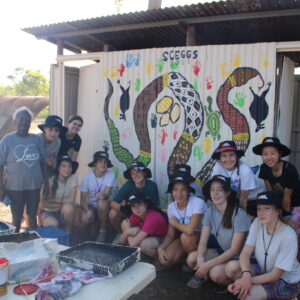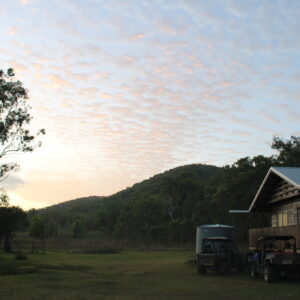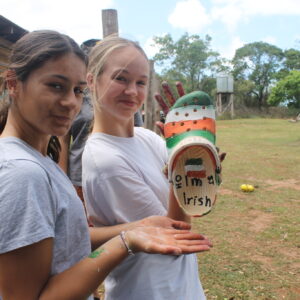
SCEGGS Stories of Immersion in Indigenous Australia
We hope you enjoy reading a range of reflections about Stories of Immersion in Indigenous Australia from the students this week. For the previous week’s reflections see here.
Reflections from the Cape York Immersion (Red Group)
The Cape York Immersion trip was one that was full of learning, connecting and appreciation. Throughout those 10 days, I was able to gain a new understanding of what it’s like to live on country and experience the sharing of culture by immensely knowledgeable and proud traditional owners.
Our first stop was Melsonby, a homeland decked with red earth and tall trees. There, we were hosted by the Balnggarrawarra traditional owners who were all so welcoming and eager to share their various pieces of knowledge and skills with us.
One of the standout moments of this homeland was our visit to a cave filled with Indigenous rock art. It was incredible to see how the artwork has built up over time, with the varying levels of fadedness reflecting the age of each piece. The way that stories and history could be told in such a unique and rich way, using just one colour really amazed me and this will be a site that will remain in my memory as one of the coolest and most special things I’ve ever visited.
Alongside this, we were lucky enough to have the opportunity to participate in many Indigenous activities. For example, Larry taught us how to make a humpy, which is a tent-like structure made of sticks and bark. Wet bark which has been soaked overnight is used to bind wet and flexible sticks into a frame. Dry sheets of bark are then draped onto this frame to create walls. It all came together relatively quickly and easily and I was amazed at the resourcefulness and effectiveness of these structures. Ginger also taught us how to make bracelets using a traditional weaving technique. After cutting off the thorns, the brittle leaves of the pandan plant are heated over a fire to make them flexible enough to weave strips in and out of each other. In the end, we were left with a stunning checkerboard pattern and an accessory to wear for the rest of the trip, reminding us of Melsonby.
One of the things that stuck with me most was the message that: if you care for mother earth, she will care for you and that everything comes back around to you. Good deeds will have their rewards and bad actions will always have their consequences. The traditional owners’ dedication to maintaining and protecting the land through practices such as mosaic burning and creating barriers to prevent excess sediment from reaching waterways is extremely evident and it’s clear that they have an extensive knowledge about how to protect the environment.
The second homeland we went to was Binthi-Warra, where we were hosted by Mel and her family. Mel made sure to emphasise the importance of education as a step towards reconciliation. She hopes that by having and teaching students on the Binthi-Warra homeland, they will then be able to pass on the stories and knowledge when they go back home. She also hopes that people will be able to see the successes and brightness of Indigenous peoples and their culture as the media tends to only focus on the negatives, thus painting Indigenous people in a harmful light. We watched a documentary which highlighted this brightness in a town called Hope Vale, where there is a strong sense of community and pride in culture through various communal events. We were able to visit Hope Vale and its art centre which was filled with absolutely beautiful artwork by Aboriginal artists.
Additionally, Mel taught us how to make bullroarers which are weapons used to hunt small animals. We traced, sawed and sanded wood before attaching it to rope. When spun fast enough, a low whirring sound is made. On the same day, we also made dance shakers used for corrobborees. We cut burnie beans in half and attached them to rope with a loop at the top. You can put your hand in the loop and when you shake it, the beans clack together to make a percussive noise. Mel also heated leaves in a pot of water to create a black dye for us to tie-dye small bags. Plants such as kangaroo paw can also be used to create dyes which were traditionally used to dye baskets. All of the different ways that natural materials and the surrounding landscape is used is so creative! On the final night, Mel’s daughter and niece, Riley and Alex taught us some Indigenous dances. It was so cool to see girls of similar ages to us be so enthusiastic and proud to share their culture with and it’s amazing to know that Indigenous traditions will continue to be carried on by future generations.
Of course, this is only a snapshot of all the things we learnt, did and appreciated over the course of the immersion, including all the hikes (we ate green ants; they tasted like lemon sherbet!), mural painting and conversations. After departing the homeland, I was left with feelings of immense gratitude and awe at the generosity and welcoming nature of all of the traditional owners. In everything they did, they were bursting with passion and an excitement to share their knowledge with us. I feel so grateful to have had this opportunity to experience another chunk of such a complex and rich culture.
Gabrielle Cheung
Year 10
Reflections from the Cape York Immersion (Yellow Group)
On November 30, 2022 I received confirmation that I would be attending Cape York in late September 2023. At that moment, it felt like a distant event, and I believed I had a whole year to prepare for the early morning wakeup and the journey to the airport. The prospect of no contact with my friends or family for 10 days in a completely unfamiliar environment from my day-to-day life, seemed almost unimaginable. However, as September approached, my excitement grew, and I eagerly anticipated the adventure that lay ahead.
I was filled with emotions, wondering what this experience would be like. In the lead-up to the trip, we were promised so much – a new perspective, the opportunity to forge new friendships with students from my year, Year 10, and the teachers, a lasting bond with the traditional owners after just a few days, personal growth that would impact my life back in Sydney, and traditional knowledge that we had never encountered in a classroom. Looking back now, I can say wholeheartedly those 10 days changed me. If I were to share one piece of wisdom from my schooling journey, it would not be about how to study for exams or choosing the right friends; it would be to sign up for Cape York and submit your expression of interest. I can promise that when you return to your family, you will not only have 50+ pages of journaling to share, but also an abundance of knowledge and personal growth.
Finally, September 24 arrived. Though I had been emotional and apprehensive the day before, I was ready and excited. The bustling atmosphere of 50 girls and teachers at the Sydney Domestic airport assured me that I was about to embark on the journey of a lifetime. I was fortunate to be in the company of Ms. Tring, Ms. Connolly, Ms. Anderson, and Miss Styles, who provided us with unwavering support and love throughout our trip, even when they themselves weren’t entirely certain.
During our trip, we visited two communities – Yungee Bush Camp and Loggee Crossing. At Yungee Bush Camp, we were welcomed by Dez and Estelle and their extended family, who shared their stories with us. In the next homeland, Loggee Crossing, Trev and Dorah taught us various cultural practices, such as spear-making and how to bake the perfect damper.
This Immersion profoundly reshaped my understanding of Indigenous Australia. It fostered a deep cultural awareness and a heightened appreciation for indigenous art, customs, language, and spirituality. At Yungee Bush Camp, they presented our team leader, Daniel, with a hand-painted didgeridoo, and both Year 9 and Year 10 received wooden paintings crafted from the stump of a tree. At Loggee Crossing, Tammy shared her family’s language with us. Throughout the entire journey, I gained an entirely new historical perspective, acquiring insight into their history, the impact of dispossession on their families, and the devastating government policies they have endured. Understanding this historical context has allowed me to comprehend contemporary issues. Our experience with the connection to the land shared by both homelands was incredibly enlightening, emphasizing the significance of land, spiritual connection, and the ongoing struggles for rights and environmental conservation.
Judy (Dez and Estelle’s daughter) shared the challenges they face in protecting their land from mining companies, underscoring the lack of support they receive. Witnessing the diversity of perspectives and lifestyles between the two homelands, both driven by shared values of family, connection to land, and culture, was eye-opening and challenged our preconceptions. This immersion has inspired us to become advocates for indigenous rights and reconciliation, recognising the importance of supporting initiatives that promote social justice, land rights, and cultural preservation.
When I returned home, I was no longer the same person I was 10 days prior. I returned with a heightened awareness of the critical issues facing our country. It is disheartening that in 2023, we still cannot pass a referendum for Indigenous representation in the Australian Parliament. We must take responsibility for the violence, massacres, loss and diseases colonisers have caused. We must stand up and take action. For me, it means sharing the knowledge I have accumulated with my friends and family and continuing these conversations long after the 10-day immersion. Participating in indigenous initiatives will help us support and advocate for indigenous rights as a school, and self-education and educating those around us are crucial if we want to move beyond mere recognition of the pain we have caused.
There were common threads that ran through both homelands we visited. The sense of family was profound in every moment we spent in the communities. It went deeper than I had ever imagined, and it was evident that family was vital to them. They welcomed us as a group, and the children played, danced, and shared their skills, fostering a sense of togetherness that was unlike anything I had experienced before. The knowledge we gained was different from anything we had ever read in books, articles, or learned in the classroom at SCEGGS. These real-life stories could not be found in any written text, and that was a significant revelation for me. Additionally, the contrast between our lifestyles and theirs is striking. I envied the carefree childhood of the children as they played on their great-grandparents’ land, displaying endless bravery and an intense connection to their culture and land.
I can distil the highlights of this trip into three significant moments. First, Judy’s talk at Yungee Bush Camp left a lasting impression on me. Her anecdotes, including encounters with crocodiles, highlighted the continuity of their knowledge from generation to generation. She told a story about how every time mining companies encroach on their land, rain falls, preventing their operations. Their family believes her great-grandfather, known as the “rain man,” sends the rain each time. She emphasised, “If we can’t speak loudly enough to protect our land, our ancestors will.” At Loggee Crossing, Dez, Trev, and Naz’s campfire songs and concert showcased their strong connection, to culture and musical talents. Their songs reflected their love for one another, their passions, their cultures, and the suffering they endured. It was a profoundly emotional experience for all of us, and it’s a memory I will cherish throughout my life. Our day at the Great Barrier Reef was another highlight, where they shared their knowledge about the coral and species we observed, performed cultural dances with traditional instruments, and applied ochre to our faces. It was a moment of connection and pride in their culture and identity.
This indigenous immersion experience was truly eye-opening. It provided profound insights into their culture, history, and traditions, expanding my knowledge and deepening my commitment to fostering cultural understanding while challenging stereotypes. I am immensely grateful to the communities that opened their homes and hearts to us, and I am excited to continue this learning journey.
Helena O’Brien
Year 9
Reflections from the Top End Immersion
Educating oneself in the world of upheaval we live in is of paramount importance. Simply taking a backseat in events that weave the fabric of society is a privilege, and the onus of change rests on the shoulders of people like myself. Given how topical Indigenous affairs have become in recent times, especially with the conversation surrounding the Voice, my immersion experience has made me aware of my role in the process of reconciliation. My journey to Top End is incomparable to any other experience I have taken part in. When speaking to Miriam Rose, an incredible Indigenous activist, she stressed the importance of ‘walking life in two paths’, living presently in my own life in the city whilst acknowledging the remote life hat was developed while I was away. She said the best thing that can be done towards reconciliation is doing what we were doing – showing a genuine desire to learn and educate those who weren’t as fortunate as us to have the firsthand experience. I can’t help but feel grateful for the life I lead as it is vastly different to the life I led in the Northern Territory, but my life has most definitely been changed following the trip. The most important take away from the immersion was to stay inquisitive and curious. Through asking questions and listening to the answers so much change is made possible, and its incredibly simple yet so significant. I am immeasurably grateful for all I’ve learnt over the course of the ten days, and am eager to continue learning.
Charlotte Katz
Year 11























